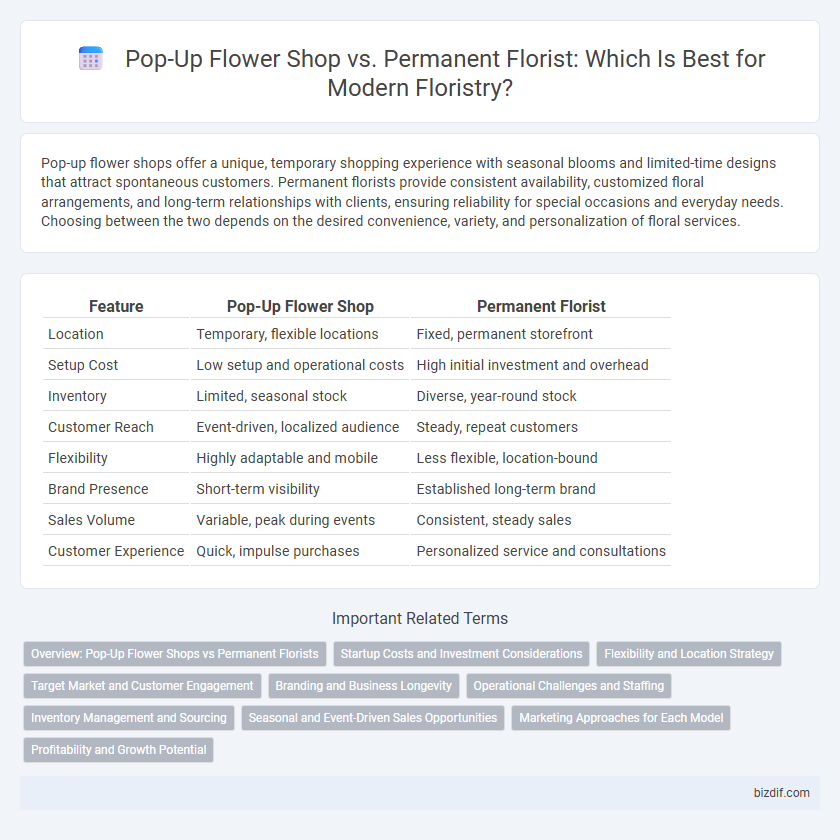Pop-up flower shops offer a unique, temporary shopping experience with seasonal blooms and limited-time designs that attract spontaneous customers. Permanent florists provide consistent availability, customized floral arrangements, and long-term relationships with clients, ensuring reliability for special occasions and everyday needs. Choosing between the two depends on the desired convenience, variety, and personalization of floral services.
Table of Comparison
| Feature | Pop-Up Flower Shop | Permanent Florist |
|---|---|---|
| Location | Temporary, flexible locations | Fixed, permanent storefront |
| Setup Cost | Low setup and operational costs | High initial investment and overhead |
| Inventory | Limited, seasonal stock | Diverse, year-round stock |
| Customer Reach | Event-driven, localized audience | Steady, repeat customers |
| Flexibility | Highly adaptable and mobile | Less flexible, location-bound |
| Brand Presence | Short-term visibility | Established long-term brand |
| Sales Volume | Variable, peak during events | Consistent, steady sales |
| Customer Experience | Quick, impulse purchases | Personalized service and consultations |
Overview: Pop-Up Flower Shops vs Permanent Florists
Pop-up flower shops offer a flexible, short-term retail experience that capitalizes on seasonal demand and trends, often set up in high-traffic urban locations to attract spontaneous buyers. Permanent florists maintain a consistent presence with a fully equipped store, providing an extensive variety of floral arrangements, custom services, and long-term customer relationships. Both options serve distinct market needs, with pop-ups excelling in novelty and immediacy, while permanent florists offer reliability and comprehensive floral expertise.
Startup Costs and Investment Considerations
Pop-up flower shops require significantly lower startup costs compared to permanent florists, as they often operate with minimal inventory and temporary locations, reducing rent and utility expenses. Permanent florists demand higher initial investments in storefront leasing, equipment, and long-term staff, alongside consistent inventory purchases to maintain a full-service operation. Evaluating these financial commitments is crucial for entrepreneurs aiming to balance flexibility with sustained customer engagement in the floristry market.
Flexibility and Location Strategy
Pop-up flower shops offer unparalleled flexibility in location strategy, allowing florists to test high-traffic areas and seasonal hotspots without long-term lease commitments. Permanent florists benefit from consistent customer bases and brand establishment but face limitations in adapting quickly to market shifts or exploring emerging neighborhoods. Leveraging pop-up shops can optimize market reach, while permanent locations provide stability and ongoing community presence in strategic locations.
Target Market and Customer Engagement
Pop-up flower shops attract a transient target market seeking convenience and unique, seasonal arrangements, often appealing to event attendees or impulse buyers. Permanent florists cater to a loyal, local customer base with personalized services, including custom orders and floral design consultations. Customer engagement in pop-up shops relies heavily on social media promotions and foot traffic, while permanent florists build long-term relationships through consistent quality and community involvement.
Branding and Business Longevity
Pop-up flower shops provide dynamic branding opportunities by creating unique, time-limited experiences that generate buzz and attract diverse customer segments. Permanent florists build lasting brand recognition through consistent service, community presence, and customer loyalty, which supports sustainable business growth. Investing in a permanent storefront enhances business longevity by establishing reliable revenue streams and enabling deeper market penetration.
Operational Challenges and Staffing
Pop-up flower shops face operational challenges such as limited space, temporary setups, and unpredictable customer flow, requiring flexible and multi-skilled staff to manage varying tasks efficiently. Permanent florists benefit from established workflows, consistent supplier relationships, and stable staffing, allowing for specialization and long-term workforce development. Staffing in permanent florists often involves trained florists and dedicated roles, while pop-up shops rely on adaptable workers capable of handling both sales and floral arrangements in fast-paced environments.
Inventory Management and Sourcing
Pop-up flower shops often rely on local, seasonal blooms with limited inventory to ensure freshness and minimize waste, using flexible sourcing from farmers markets and nearby growers. Permanent florists maintain extensive, diversified stock through established supplier relationships, enabling consistent availability of a wide variety of flowers year-round. Efficient inventory management for permanent shops includes advanced forecasting and refrigerated storage, contrasting with the pop-ups' just-in-time purchasing approach.
Seasonal and Event-Driven Sales Opportunities
Pop-up flower shops capitalize on seasonal trends and event-driven sales by providing limited-time offerings tailored to holidays and local celebrations, creating urgency and exclusivity that attract spontaneous buyers. Permanent florists benefit from steady year-round sales and customer loyalty but may miss out on the heightened demand during peak seasons like Valentine's Day or Mother's Day without flexible inventory adjustments. Leveraging pop-up shops for timely events complements the stable presence of permanent florists, maximizing revenue across diverse market conditions.
Marketing Approaches for Each Model
Pop-up flower shops leverage scarcity marketing and localized social media campaigns to create urgency and attract spontaneous buyers, often capitalizing on trending events or seasonal demand. Permanent florists invest in brand loyalty through consistent community engagement, subscription services, and targeted email marketing that builds long-term customer relationships. Each model utilizes tailored content strategies: pop-ups focus on immediate visual impact and limited-time offers, whereas permanent shops emphasize storytelling, expertise, and reliability in floral design.
Profitability and Growth Potential
Pop-up flower shops offer low initial investment and flexible locations, driving quick cash flow and market testing opportunities, which can boost short-term profitability. Permanent florists benefit from brand establishment, customer loyalty, and consistent revenue streams that support long-term growth potential. Analyzing market demand and operational costs helps determine which model maximizes profitability and scalability in the floristry industry.
Pop-Up Flower Shop vs Permanent Florist Infographic

 bizdif.com
bizdif.com